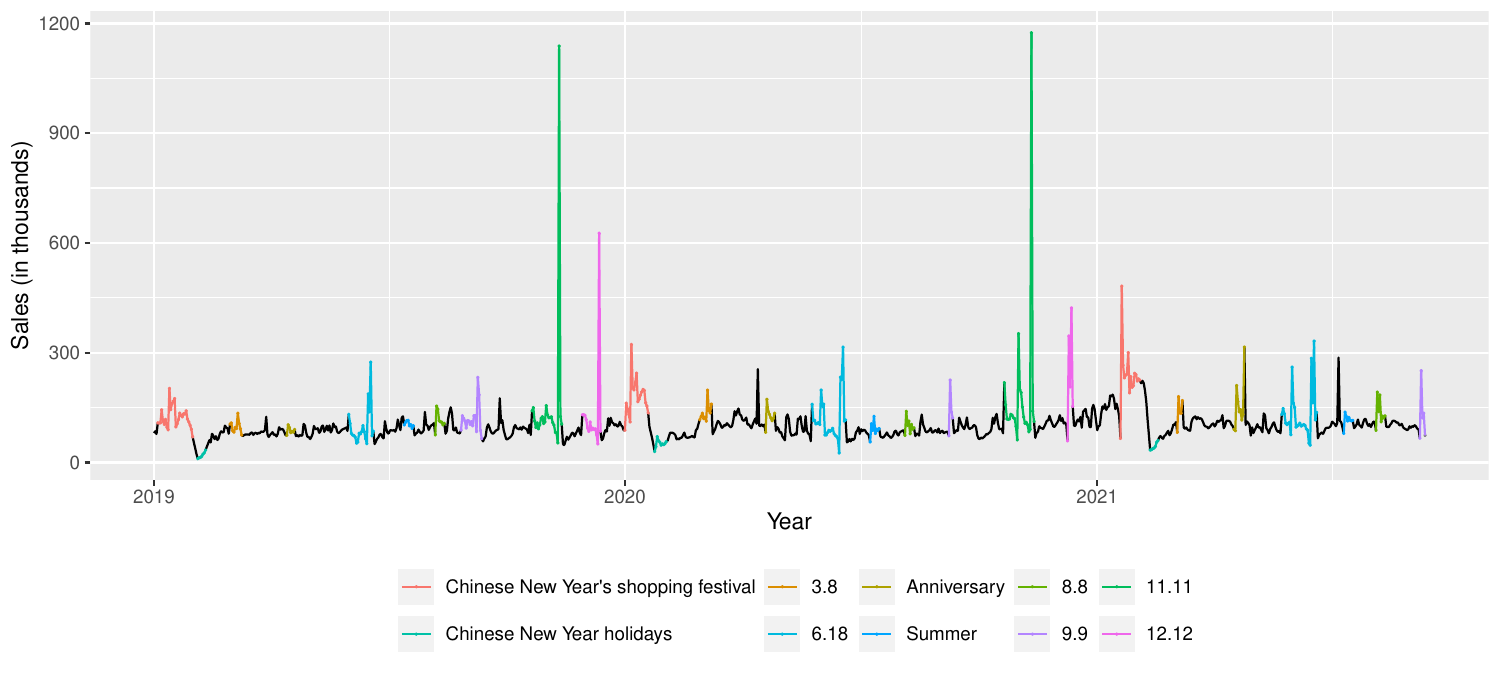Reconciliation
with Immutable
Forecasts
Anastasios Panagiotelis
December 1, 2022
Joint work with
Bohan Zhang 
Joint work with
Bohan Zhang 
Yanfei Kang 
Joint work with
Bohan Zhang 
Yanfei Kang 
Feng Li 
Reconciliation background
Hierarchical Time Series
- Multivariate forecasting problem.
Hierarchical Time Series
- Multivariate forecasting problem.
- Variables follow linear constraints.
Hierarchical Time Series
- Multivariate forecasting problem.
- Variables follow linear constraints.
- Forecast store level sales and aggregates.
Problem context
- Have base forecasts at all nodes. How can we make these coherent?
Problem context
- Have base forecasts at all nodes. How can we make these coherent?
- Bottom Up (Schwarzkopf, Tersine, and Morris, 1988) ignores top nodes.
Problem context
- Have base forecasts at all nodes. How can we make these coherent?
- Bottom Up (Schwarzkopf, Tersine, and Morris, 1988) ignores top nodes.
- Noise in bottom level transferred to top level.
Problem context
- Have base forecasts at all nodes. How can we make these coherent?
- Bottom Up (Schwarzkopf, Tersine, and Morris, 1988) ignores top nodes.
- Noise in bottom level transferred to top level.
- Top Down (Gross and Sohl, 1990) ignores bottom nodes.
Problem context
- Have base forecasts at all nodes. How can we make these coherent?
- Bottom Up (Schwarzkopf, Tersine, and Morris, 1988) ignores top nodes.
- Noise in bottom level transferred to top level.
- Top Down (Gross and Sohl, 1990) ignores bottom nodes.
- Discards information.
- Can bias even unbiased base forecasts.
Reconciliation
- Base forecasts stacked in an n-vector ^y.
Reconciliation
- Base forecasts stacked in an n-vector ^y.
- Reconciled forecasts ~y given by ~y=S(S′WS)−1S′W^y
Reconciliation
- Base forecasts stacked in an n-vector ^y.
- Reconciled forecasts ~y given by ~y=S(S′WS)−1S′W^y
- Different choices of WW give rise to different methods.
Reconciliation
- Base forecasts stacked in an n-vector ^y.
- Reconciled forecasts ~y given by ~y=S(S′WS)−1S′W^y
- Different choices of WW give rise to different methods.
- The original is WW=II (Hyndman, Ahmed, Athanasopoulos, and Shang, 2011).
What is SS?
yy=SSbb
What is SS?
yy=SSbb
S=⎛⎜ ⎜ ⎜ ⎜ ⎜ ⎜ ⎜ ⎜ ⎜ ⎜ ⎜⎝1111110000111000010000100001⎞⎟ ⎟ ⎟ ⎟ ⎟ ⎟ ⎟ ⎟ ⎟ ⎟ ⎟⎠
Why optimal? Minimises expected loss
MinT method (Wickramasuriya, Athanasopoulos, and Hyndman, 2019) minimises
E[(yy−~yy)′(yy−~yy)]
if WW is set to the inverse forecast error covariance of the base forecasts.
Why optimal? Minimises expected loss
MinT method (Wickramasuriya, Athanasopoulos, and Hyndman, 2019) minimises
E[(yy−~yy)′(yy−~yy)]
if WW is set to the inverse forecast error covariance of the base forecasts.
- Subject to linearity and constraint that unbiasedness of base forecasts is preserved.
Why optimal? Always improves loss
- Reconciliation also minimises
(~yy−^yy)′WW(~yy−^yy)
- Subject to ~yy being coherent.
- Guarantee (yy−^yy)′WW(yy−^yy)≥(yy−~yy)′WW(yy−~yy)

With non negativity
- For data that cannot be negative can minimise
(~yy−^yy)′WW(~yy−^yy)
- Subject to the coherence constraint.
- Subject to the constraint that ~yi≥0 for all i.
With non negativity
- For data that cannot be negative can minimise
(~yy−^yy)′WW(~yy−^yy)
- Subject to the coherence constraint.
- Subject to the constraint that ~yi≥0 for all i.
- Solved by QP using a block pivoting algorithm (Wickramasuriya, Turlach, and Hyndman, 2020).
With non negativity
- For data that cannot be negative can minimise
(~yy−^yy)′WW(~yy−^yy)
- Subject to the coherence constraint.
- Subject to the constraint that ~yi≥0 for all i.
- Solved by QP using a block pivoting algorithm (Wickramasuriya, Turlach, and Hyndman, 2020).
- Theory does not follow through, but useful in practice.
Motivation
Joint loss function
- Everything we know about why reconciliation works applies to a joint loss function.
Joint loss function
- Everything we know about why reconciliation works applies to a joint loss function.
- Forecast accuracy for individual variables may become worse after reconciling.
Joint loss function
- Everything we know about why reconciliation works applies to a joint loss function.
- Forecast accuracy for individual variables may become worse after reconciling.
Unbiased top down
- For 3-variable hierarchy yT=yA+yB, consider
⎛⎜⎝^yT^yA^yT−^yA⎞⎟⎠ or ⎛⎜⎝^yT^yT−^yB^yB⎞⎟⎠
or an average of these (Hollyman, Petropoulos, and Tipping, 2021).
- Top level remains unchanged (or immutable) and unbiasedness is preserved
Our contribution
- Suppose we want to keep forecasts of a subset of variables immutable.
Our contribution
- Suppose we want to keep forecasts of a subset of variables immutable.
- When is this feasible?
- How should we choose immutable series?
Our contribution
- Suppose we want to keep forecasts of a subset of variables immutable.
- When is this feasible?
- How should we choose immutable series?
- We provide a conclusive answer to the first question and some suggestions (with an empirical example) for the second.
Is it feasible?
Feasbility check
- Cannot keep Region 1, Store 1A and Store 1B immutable
Basis series
- Choose any representation yy=SSbb.
Basis series
- Choose any representation yy=SSbb.
- Let j1,j2,…,jm be the indices of a set of proposed immutable series
Basis series
- Choose any representation yy=SSbb.
- Let j1,j2,…,jm be the indices of a set of proposed immutable series
- Construct a matrix SS{j} using the rows of SS corresponding to the indices j1,j2,…,jm.
Basis series
- Choose any representation yy=SSbb.
- Let j1,j2,…,jm be the indices of a set of proposed immutable series
- Construct a matrix SS{j} using the rows of SS corresponding to the indices j1,j2,…,jm.
- If SS{j} has full (row) rank, then yj1,yj2,…,yjm can be kept immutable.
Example
S=⎛⎜ ⎜ ⎜ ⎜ ⎜ ⎜ ⎜ ⎜ ⎜ ⎜ ⎜⎝1111110000111000010000100001⎞⎟ ⎟ ⎟ ⎟ ⎟ ⎟ ⎟ ⎟ ⎟ ⎟ ⎟⎠
Example
S=⎛⎜ ⎜ ⎜ ⎜ ⎜ ⎜ ⎜ ⎜ ⎜ ⎜ ⎜⎝1111110000111000010000100001⎞⎟ ⎟ ⎟ ⎟ ⎟ ⎟ ⎟ ⎟ ⎟ ⎟ ⎟⎠
Reconciliation
Find ~yy to minimise
(~yy−^yy)′WW(~yy−^yy)
subject to
Reconciliation
Find ~yy to minimise
(~yy−^yy)′WW(~yy−^yy)
subject to
- Coherence constraints
- Immutability constraints
- Non negativity constraints
Choosing immutable series
Application
- Sales data from Chinese online retailer
Application
- Sales data from Chinese online retailer
- Consider "Food" sales as top level.
- There are 40 "middle" level categories.
- There are 1905 "bottom" level categories.
Application
- Sales data from Chinese online retailer
- Consider "Food" sales as top level.
- There are 40 "middle" level categories.
- There are 1905 "bottom" level categories.
- Many series are intermittent.
- Promotions are very important
Top level

Setup
- Base models
Setup
- Base models
- Intermittent Series (more than 60% zeroes) use simple exponential smoothing.
- Regression (predictors are strength of promotion) with ARIMA errors and Box Cox transformation for other series.
Setup
- Base models
- Intermittent Series (more than 60% zeroes) use simple exponential smoothing.
- Regression (predictors are strength of promotion) with ARIMA errors and Box Cox transformation for other series.
- Immutable series
Setup
- Base models
- Intermittent Series (more than 60% zeroes) use simple exponential smoothing.
- Regression (predictors are strength of promotion) with ARIMA errors and Box Cox transformation for other series.
- Immutable series
- Top level
- Series with longer histories (more than 1 year)
Results
| Level | Base | C | CN | CI | CIN |
|---|---|---|---|---|---|
| Top (I) | 2.94 | 2.75 | 2.77 | 2.94 | 2.94 |
| Middle (M) | 2.66 | 2.39 | 2.40 | 2.43 | 2.47 |
| Bottom (M) | 2.04 | 1.86 | 1.83 | 1.97 | 1.88 |
| Intermittent (I) | 0.11 | 1.52 | 1.52 | 0.11 | 0.11 |
| Older (I) | 1.08 | 1.58 | 1.19 | 1.08 | 1.08 |
Conclusions
- Imposing immutability constraints still leads to improvements over base forecasts.
Conclusions
- Imposing immutability constraints still leads to improvements over base forecasts.
- Immutability stabilises forecasting performance of intermittent series in particular.
Conclusions
- Imposing immutability constraints still leads to improvements over base forecasts.
- Immutability stabilises forecasting performance of intermittent series in particular.
- Imposing immutability does not lead to better accuracy in all series.
Conclusions
- Imposing immutability constraints still leads to improvements over base forecasts.
- Immutability stabilises forecasting performance of intermittent series in particular.
- Imposing immutability does not lead to better accuracy in all series.
- Imposing non-negativity constraints generally improves performance.
Open Questions
- Can we choose immutability constraints in a more principled way?
Open Questions
- Can we choose immutability constraints in a more principled way?
- Is this another version of a shrinkage v sparsity question?
Open Questions
- Can we choose immutability constraints in a more principled way?
- Is this another version of a shrinkage v sparsity question?
- When is it possible reconcile in a way that yields Pareto improvements in forecast accuracy?
References
Gross, C. W. et al. (1990). "Disaggregation methods to expedite product line forecasting". In: Journal of Forecasting 9.3, pp. 233-254.
Hollyman, R. et al. (2021). "Understanding Forecast Reconciliation". En. In: European Journal of Operational Research 294.1, pp. 149-160. ISSN: 0377-2217. DOI: 10.1016/j.ejor.2021.01.017.
Hyndman, R. J. et al. (2011). "Optimal Combination Forecasts for Hierarchical Time Series". En. In: Computational Statistics Data Analysis 55.9, pp. 2579-2589. ISSN: 0167-9473. DOI: 10.1016/j.csda.2011.03.006.
Schwarzkopf, A. B. et al. (1988). "Top-down versus bottom-up forecasting strategies". In: International Journal of Production Research 26 (11), pp. 1833-1843.
Wickramasuriya, S. L. et al. (2019). "Optimal Forecast Reconciliation for Hierarchical and Grouped Time Series Through Trace Minimization". In: Journal of the American Statistical Association 114.526, pp. 804-819. ISSN: 0162-1459. DOI: 10.1080/01621459.2018.1448825.
Wickramasuriya, S. L. et al. (2020). "Optimal Non-Negative Forecast Reconciliation". En. In: Statistics and Computing 30.5, pp. 1167-1182. ISSN: 1573-1375. DOI: 10.1007/s11222-020-09930-0.